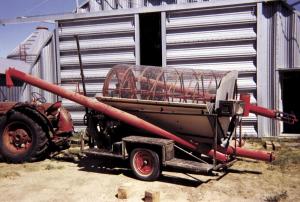2002 - Volume #26, Issue #1, Page #11
[ Sample Stories From This Issue | List of All Stories In This Issue | Print this story
| Read this issue]
He Built His Own High-Capacity Rotary Seed Cleaner
 |
 |
The rotary cleaner measures 4 ft. in diameter and almost 9 ft. long and mounts on an axle and wheels. It's powered by a 16 hp, electric start gas engine and is equipped with a pair of old Brandt augers - one for loading, the other for unloading. Both augers fold up alongside the drum for transport. The engine belt-drives the drum as well as both augers.
The drum rotates on a bearing-supported shaft and mounts above a V-shaped, plywood hopper covered with tin. An auger with slots cut into the top of it runs the full length of the hopper. The auger carries fines out the back, where they're dumped into a separate auger (not part of the machine) that loads them into a truck or wagon.
To load the cleaner, Haubrich swings the loading auger out at a 90 degree angle. It drops grain into a small hopper just ahead of the drum. The unloading auger that carries away clean grain swings upward and outward from the back part of the cleaner, via a pair of hand-operated winches.
"I and some of my neighbors have used it to clean flax, canary seed, mustard, canola, and weed seeds out of wheat, durum, lentils and chickpeas. It really works well," says Haubrich, who operates a seed cleaning plant. "I have three different-sized screens for different jobs. I was using a smaller commercial rotary cleaner but it didn't always have enough capacity. I designed it so that nothing runs any faster than it has to. Even when my seed cleaner is working the engine runs just slightly above idle.
"I pull it behind my pickup or tractor, and also rent it to neighbors who come and pick it up. It has more capacity than most rotary cleaners, which are usually only 3 ft. in diameter and 6 ft. long. I use my 1/2-ton pickup to pull it down the highway.
The shaft that the drum rotates on came out of an old combine pickup. He bought new screens to make the drum (the only new components). The screens came in 3-ft. widths so he overlapped three of them over a round a frame made of metal tubing. A homemade clamp fits around the outside of the drum. "To change screens, I simply remove the clamp and put new ones on," says Haubrich.
Haubrich says the cleaner's capacity depends on what kind of seed he puts through it. "My son-in-law recently used it to remove lentils from canola. The Canola went through the drum as fast as he could load it, at about 600 bushels per hour. However, if you have to remove wheat from canola, the wheat will compete for the slots in the auger tube at the bottom of the drum, and is also lighter than wheat, so capacity will be limited to about 150 bushels per hour," he notes.
Contact: FARM SHOW Followup, Brian Haubrich, Box 21, Glenbain, Sask., Canada S0N 0X0 (ph 306 264-3809).

Click here to download page story appeared in.

Click here to read entire issue
To read the rest of this story, download this issue below or click here to register with your account number.




